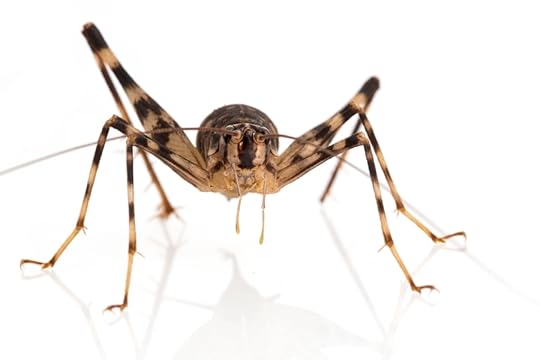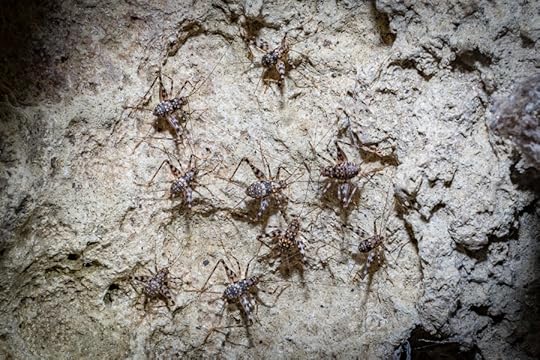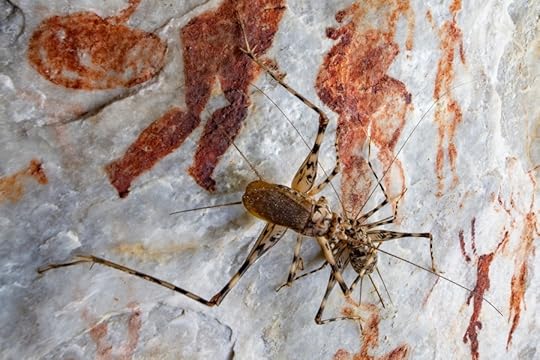Silently speaking
Crickets are some of the oldest and best studied singers of the animal world. Their ancestors were probably some of the first animals to break the silence of the dry land in the Permian and the Triassic (acoustic communication underwater had probably appeared long before that, albeit fossil evidence for that is scant.) The ubiquity of cricket calls is so pervasive that even people who live in colder climates where crickets are rare will immediately recognize the sound. Their calls are so ingrained into the human psyche that it is difficult to image a nocturnal soundscape without at least one species contributing to the ambience. The sound of the call is produced in the typical orthopteran fashion, by using one part of the body to rub against another (in this case, the underside of the right front wing against the top of the left one), a mechanism known as stridulation.
There are many advantages of using sound for communication. Unlike the size and color of sexually-selected ornaments (e.g., the claw used by fiddler crabs to attract females), which usually give a good indication of the male’s fitness but do not require a tremendous expenditure of energy, sound is considered an “honest signal” – females judge the males by both the loudness and duration of the call, and those cannot be easily faked. Sound is directional, which allows the recipient to locate the sender, which means that a female bird can quickly find a singing male by simply following the soundwaves. Sound also allows animals to draw boundaries, and a lone lion will know not to stray too close to a certain part of the savanna because another pride is already roaring there. The ability to communicate acoustically is a superpower that allows animals to send complex messages over long distances, without the need to be visible to the recipient. This is particularly important in settings where visibility is low, such as within a dense forest, at night, or in caves.
Yet, there are drawbacks to acoustic communication. If a female can hear your call from afar, so can predators, and a high number of crickets have turned their evolutionary trajectory towards silence. Geckos, bats, even cats are known to eavesdrop on calling crickets to pinpoint and hunt them. The selective pressure of the parasitoid fly Ormia ochracea, which uses the call of singing males to locate and drop its deadly larvae on them has lead the cricket Teleogryllus oceanicus to eschew acoustic communication altogether. But in some cases, the reasons for the loss of the ability to produce sound are less clear.
 Unlike most crickets, males of Phaeophilacris lack stridulatory organs on their wings.
Unlike most crickets, males of Phaeophilacris lack stridulatory organs on their wings.  Female Pheophilacris aranea from central Mozambique
Female Pheophilacris aranea from central Mozambique In the dark cave environment it is better to stick together. Many troglobitic insects are gregarious and cave crickets are no exception.
In the dark cave environment it is better to stick together. Many troglobitic insects are gregarious and cave crickets are no exception.Crickets of the genus Phaeophilacris are large, spindly-legged creatures, found deep in the caves across Africa. In Mozambique, I often see them on the walls of caves occupied by large bat colonies, whose droppings and carcasses provide an ample and steady supply of food for the insects. Unlike other members of the large cricket family Phalangopside, Phaeophilacris have no hearing organs (tympanum) on their front tibia and the males lack stridulatory organs on their wings. This seems odd, since the darkness of the cave should make sound the ideal medium for communication and finding each other. But perhaps millions of years of coexistence with bats, animals known to target singing insects, exerted enough selective pressure to eliminate the risk of being overheard by the winged predators by removing the sound-producing organs and, consequently, the organs needed to hear it. But then, how do these mute and deaf animals manage to find mating partners in the complete darkness? And even if they find each other, what criteria do they use to decide who is and who isn’t a good one to entangle their genes with?
Phaeophilacris solved the first problem by overcoming the typically high levels of territoriality and aggression found in most crickets by becoming highly gregarious animals. Colonies of cave crickets often consist of dozens or hundreds of animals, squeezed together into crevices and holes in the walls of the cave. Even when out and about looking for food, their extremely long appendages covered with highly sensitive trichobothria (“hairs”) allow the crickets to be always in touch with other members of the group. In such tight settings, males can easily smell and detect females with their antennae as soon as the time for courtship comes.
 Ancient painting on the wall of a cave in Chimanimani National Park in Mozambique create the perfect background for the courtship of crickets Phaeophilacris cf. spectrum.
Ancient painting on the wall of a cave in Chimanimani National Park in Mozambique create the perfect background for the courtship of crickets Phaeophilacris cf. spectrum. During the courtship and once the female is properly charmed, the male moves to the next stage by gently caressing her with his antennae and the front legs.
During the courtship and once the female is properly charmed, the male moves to the next stage by gently caressing her with his antennae and the front legs.How do females decide if a particular male has got what it takes to produce the best offspring? In acoustic species, the volume and duration of the call are good, honest indicators of the male’s fitness, but what if you can no longer sing? Luckily for the males, they still have the wings and they have evolved a way of using them in an ingenious way that provides a good proxy for the quality of their genes. When a male encounters an interested female, he lifts his wings up and holds them vertically and perpendicularly to the body axis. Then, he begins to flick them forward, with each movement sending a single vortex of compressed air towards the female. She cannot hear this, of course, but a series of specialized trichobothria on her cerci, the long appendages at the tip of her abdomen, immediately detect and measure the power of these puffs of air. The vortex travels with the speed of 40 cm/second and is detectable by her from 15 cm away. If she finds them convincing enough, the courtship moves on to the next stage, where the two partners caress each other with the antennae, while the male shakes his body seductively and occasionally touches the female with his legs. Eventually, if properly enticed, the female climbs on his back and the male transfers a small spermatophore into her genital opening, concluding the proceedings.
The silent communication of crickets, which allows them to conduct their love affairs undetected by bats and other predators is pretty neat in its own right but one researcher, inspired by the crickets’ behavior, decided to copy it and design a robot that communicates with other robots using air vortices (Russel, A. 2011. Air vortex ring communication between mobile robots. Robotics and Autonomous Systems 59: 65-73). His robots were able to transmit and receive 466 ASCII characters using nothing but puffs of air. While this may seem stupid to Republican politicians, such biomimicry matters because it opens avenues for the development of efficient communication in places where optical or radio transmission of signals is impossible (in low visibility or underwater, for example), or when other modes of communication can be jammed or intercepted by bad actors.
Phaeophilacris crickets have been silently talking to each other in African caves for millions of years. Until now, nobody bothered them but recently those environments have found themselves under assault. Rampant habitat loss across the continent threatens the survival of bats, which may spell the end of the troglobitic communities, and the caves themselves are targeted by mining companies looking for limestone and bat guano. Cave crickets are just some of the countless unusual and poorly known cave inhabitants that may give us ideas for new and revolutionary technological solutions. Whether we will have a chance to be inspired by those other species is becoming less and less certain.✦
Piotr Naskrecki's Blog
- Piotr Naskrecki's profile
- 9 followers



